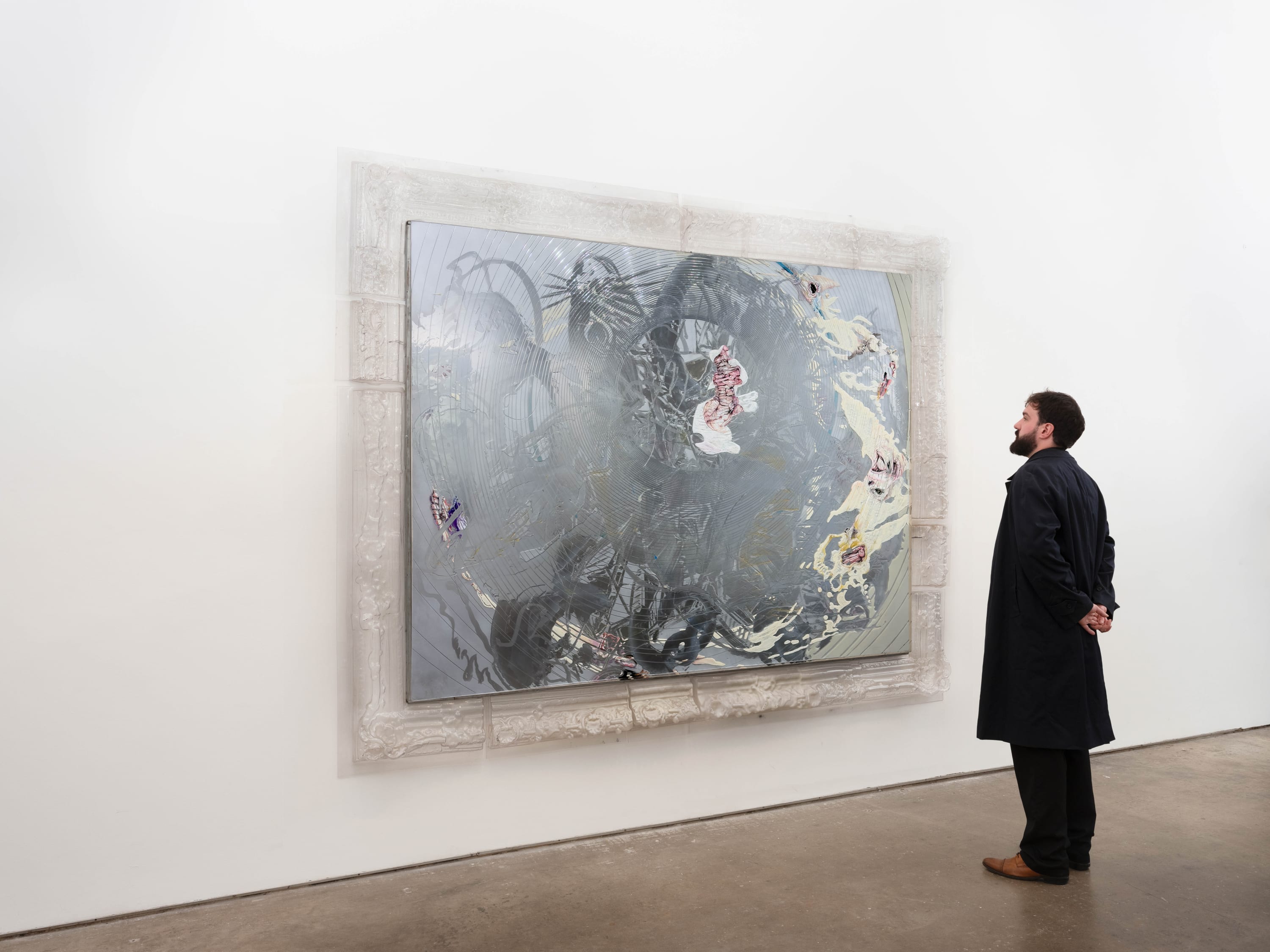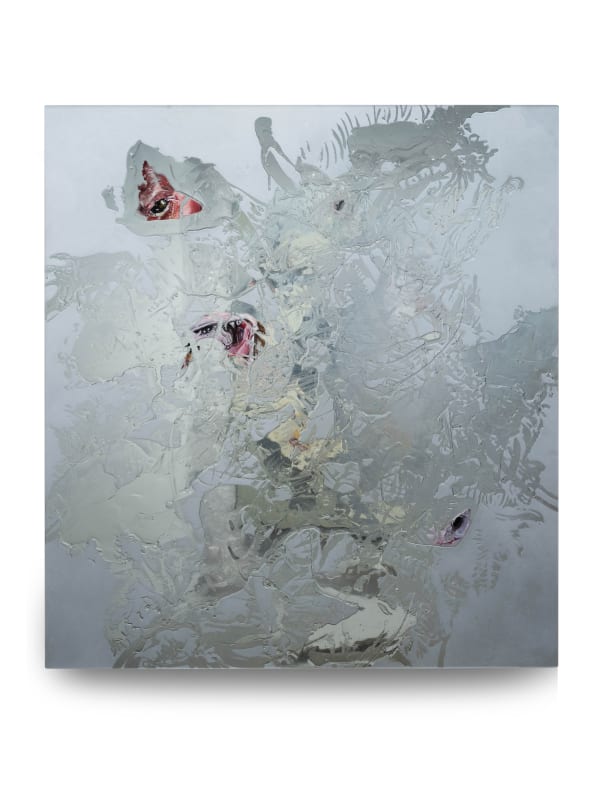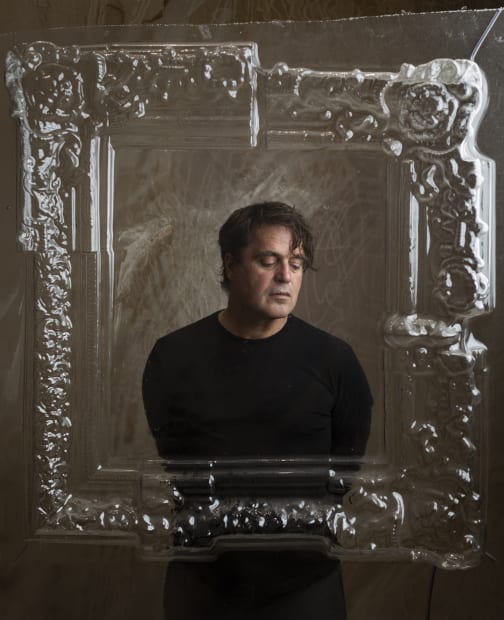-
-
Jimmy O'Neal
Spittin' Image
Johnson Lowe Gallery presents Spittin' Image, an exhibition featuring new paintings, drawings, and installations by Savannah-based, Atlanta-born artist Jimmy O'Neal. On view from February 21, 2025 – April 19, 2025, the exhibition highlights the variety of technological tools such as image-to-image AI models he's been working with for over a decade to develop a symbiotic relationship with painting and artificial intelegence. This exhibition marks O'Neal's debut exhibiton with Johnson Lowe Gallery.
-
-
The idiom “spitting image” has sparked debates about its origins, with theories ranging from “spit and image,” referencing divine creation, to “splitting image” or “spirit and image.” While these theories point to likeness, they miss the complexities of representation in a hyperreal age, where the lines between image and reality blur into simulacra. Jean Baudrillard’s concept of hyperreality, as explored in Simulacra and Simulation, offers a key framework for understanding this shift. Hyperreality, as defined by Jean Baudrillard in Simulacra and Simulation, suggests that the boundary between the real and the simulated has dissolved, so what we perceive as “real” is, in fact, a simulation. In this world, AI, media, and technology not only mimic reality but reshape it entirely. This blurring of lines between the real and simulated runs throughout O'Neal's Spittin' Image. The artist’s practice has, since the 1990’s, explored AI and other cutting-edge technologies as a mirror of the society that created it, a reflection of our collective consciousness and beliefs. This reflection often stretches across the digital, dreamlike, and physical realms—creating a space where reality itself is in constant flux.
-

Jimmy O'Neal
7 Rays on a Twin Bed Head Board, 2025“The AI generation of the moment is the spitting image of its collective societal parent—a creature of wonderment reflecting our connection to a panpsychic consciousness landscape in all its forms: digital, inner dream space, and what we consider IRL, shaped by past, present, and future simultaneously.”
– Jimmy O’Neal
-
-
-
-
-
-
In Spittin’ Image, O'Neal uses a variety of technological tools, primarily AI, such as image-to-image models, to explore how machines interpret concepts like "spitting" or "casting out." These interactions result in new paintings and installations that, through O’Neal's playful yet profound lens-based paint techniques, reflect the ever-shifting, multi-layered experience of contemporary life. The paintings themselves become an embodiment of this exchange, incorporating layers of a mirrorized paint engineered by the artist and fragmented imagery that reflects O’Neal’s own act of physically spitting paint onto the canvas - as reimagined by AI. The act of spitting is both deeply personal and symbolic and serves as an emblem of a broader societal dialogue. Through this dialogue with AI, O'Neal creates multi-dimensional, abstract representations of time—where past, present, and future collapse and the boundaries between what we know and what we can imagine are as fluid as “reality” itself.
-
In his Spittake series, O’Neal explores the fluid nature of perception, the way images form, break apart, and reform—both in the mind and in the mirrored surface. Through O’Neal’s signature high-velocity clear acrylic on frosted plexi, he brings together the spontaneous and the computational, allowing machine-learning models to participate in a conversation about likeness and recognition. The works extend from the idea of a "spitting image"— a doubling, a near-exact reflection — but push it further.
-
Faces emerge, flicker, and merge, infused with AI-generated textures and painterly distortions, forming a kind of visual improvisation. Rather than unsettling, the effect is playful, even wondrous—like glimpsing a familiar face in a passing cloud or seeing oneself in a rippling pond. The paintings act as portals, suggesting that identity, much like paint itself, is something poured, stretched, and remixed over time.
What at first glance appears as a moment of disruption—like a reflexive spit take—becomes, instead, a moment of expansion. The mirrored surface doesn’t just reflect; it integrates. The viewer is absorbed into the work, caught between past and future versions of themselves, between recognition and possibility. These works are not about fracture but about fluidity — the way images, like ideas, like histories, like selves—are never fixed but always becoming.
-
-
Horton: Clutching at the Glistening Divine — Jimmy O’Neal
A spectral vision seared onto paper through an electric arc, Horton: Clutching at the Glistening Divine stands as an artifact of a process both mechanical and alchemical. The figure—born from the eerie logic of a machine dream—arrives through the artist’s pointed interrogation of artificial intelligence. Fed a poetic impossibility—“kissing a ring of smoke”— the AI returned a homunculus, (a Suessian “Horton” sensing a frequency both macro and micro — this is the who Horton heard), a warped emissary of a realm where the immaterial is made flesh, or at least, image.
The composition evokes the medieval grotesques of Hieronymus Bosch, yet its execution is unmistakably modern: the surface is punctured by apertures formed by controlled electrocution, their scorched edges framing glimpses of mirrored mylar beneath. The viewer, shifting before the work, sees themselves caught in the fissures, implicating them in its spectral topography. The large-scale scroll, unspooling onto the gallery floor, hints at historical manuscript and digital feed—both sites of knowledge, both bound to authority.
A meditation on power, ephemerality, and the spectral mechanics of image-making, the work conjures the paradox of “kissing the ring.” Is it a futile act of devotion or a necessary performance within structures of control? In an age of AI-generated mysticism, where even a ring of smoke may be kissed, the work asks: in whose domain do we kneel? -

Spittin' Image: Jimmy O'Neal
Current viewing_room








